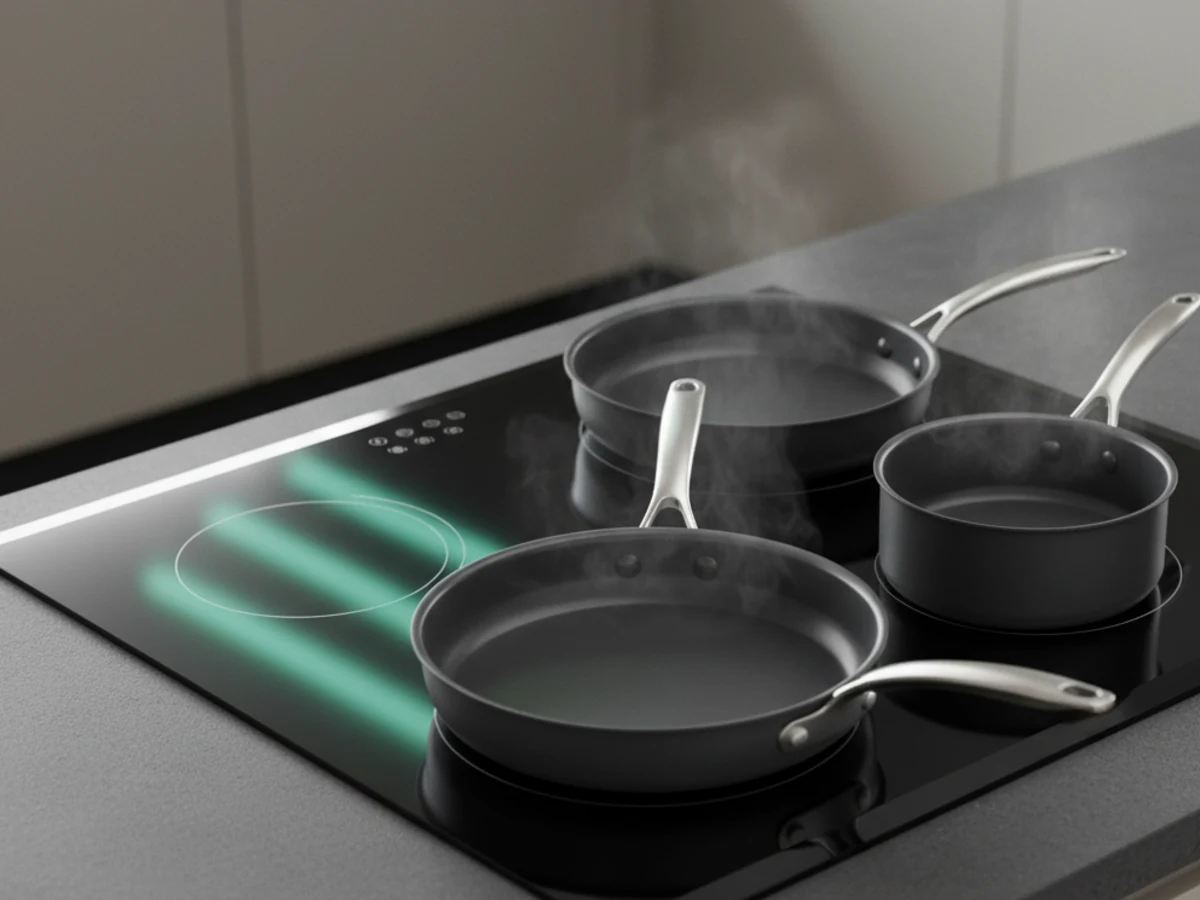We test and recommend cookware. If you purchase through links on this site, we may earn a commission at no cost to you. Our reviews are independent and based on measurable factors like build, materials, usability, and care requirements.
2025 Titanium Cookware Guide
Understand construction, safety, and maintenance so your titanium-reinforced pans stay slick and even for the long haul.

TL;DR
- What “titanium” means: Most home pans use aluminum or stainless bodies with titanium-reinforced nonstick for durability and light weight.
- Specs that matter: oven-safe label, induction-ready base (magnet sticks), comfortable weight for your wrist, and a handle that stays cool on stovetop.
- Top pick class: mid-weight, induction-ready 10–12" skillet with oven rating ≥ 400°F.
- Care: medium heat, no aerosol sprays, hand-wash after cooling; use silicone or wood tools.
How to evaluate a titanium pan in-store
- Verify construction. Look for aluminum or stainless body with titanium‑reinforced PTFE or ceramic; confirm the printed oven‑safe rating.
- Check balance & weight. A typical 10" skillet runs about 1.6–2.6 lb. Grip at the handle’s midpoint; it should feel steady without wrist strain.
- Confirm induction. Use a small magnet on the base; firm stick = compatible.
Quick answer
Buy titanium-reinforced cookware for durable nonstick without excess weight. Prioritize an oven-safe rating that matches your recipes (many are 350–500°F), an induction-ready base if needed, and a balanced handle. Longevity comes from medium heat and gentle cleaning.
PTFE vs ceramic “titanium” coatings
VS
| Attribute | Titanium‑reinforced PTFE | Titanium‑reinforced ceramic |
|---|---|---|
| Heat handling | Great at low/medium; avoid scorching heat for longevity | Similar; some tolerate slightly higher surface temps but verify label |
| Release feel | Very slick out of box | Slick; may need a touch more oil over time |
| Oven-safe labeling | Commonly 350–500°F | Commonly 350–500°F |
| Induction dependency | Needs magnetic base layer | Needs magnetic base layer |
| Care difficulty | Low with gentle tools; avoid aerosol sprays | Low; avoid abrasives and sprays |
How titanium cookware is built
Quality pans typically combine an aluminum core (fast, even heating) or clad stainless body with a titanium-fortified PTFE or ceramic blend that resists abrasion. A magnetic steel disc or layer is added when the line supports induction ranges.
Checklist
- Anodized aluminum or clad stainless body
- Clear oven-safe temperature printed on packaging/manual
- Magnetic base (for induction)
- Riveted stainless or silicone-wrapped handle with comfortable balance
Because aluminum spreads heat well while titanium improves coating durability, this pairing balances performance and lifespan.
Specification benchmarks
| Item | Lower bound | Upper bound |
|---|---|---|
| Pan thickness (mm) | ~2.5 | ~4.2 |
| Oven-safe label (°F) | 350 | 500 |
| Weight for 10" skillet (lb) | ~1.6 | ~2.6 |
| Warranty language | 2-year limited | Limited lifetime |
Ranges shown for orientation only. Always confirm the exact spec on the manufacturer page or manual.
Best use cases
Weeknight eggs
Low to medium heat, a touch of oil or butter, and a silicone spatula keep release excellent.
Fish & delicate proteins
Start with preheated pan and dry fillets. Flip once; oven finish only within the labeled limit.
Quick sautés
Mid-weight pans shine on veg and stir-fries. For hard searing, consider stainless or cast iron.
Care & cleaning (the short version)
- Let the pan cool before washing; thermal shock can stress coatings and bases.
- Use mild soap and a soft sponge; avoid abrasive pads.
- Skip aerosol sprays; propellants can polymerize and hamper release.
- Use silicone or wood tools; store with felt protectors or hang.
For deeper guidance, see the full care guide.
Transcript
Use medium heat, avoid aerosol oils, hand-wash after the pan cools, and use silicone or wood tools. Check your model’s oven and induction labels, then store with protectors.
Testing notes & verification
When comparing pans, we look for evenness, release, and handle comfort. For third-party methodology examples, see Consumer Reports’ cookware testing overview. Always verify model-specific specs on the manufacturer’s site or manual before purchase.
FAQs
Is titanium cookware the same as titanium-reinforced nonstick?
Is titanium cookware safe for high-heat searing?
How do I clean a titanium-reinforced nonstick pan?
Is it dishwasher safe?
Will it work on induction?
At-a-glance comparison
Visual aid: both coating families require gentle heat and tools; confirm oven and induction labels per model.
Next steps
Shortlist pans using the spec table above, confirm warranty language on the product page, and run our care checklist after your first cook.
What changed in this update
- Clarified spec ranges and induction notes.
- Added Quick Answer snippet and expanded FAQs.
- Aligned canonical domain to itstitaniun.com.